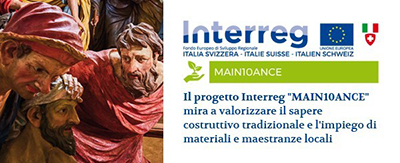Historical and artistic notes
The Riviera di San Giulio, meaning the area around the lake was ruled by the bishop of Novara since the 11th century. The legend says that in 1538, the wooden sculpture of Our Lady of Mercy (XIV century), still visible on the main altar of the sanctuary dedicated to St. Nicholas from Mira, allowed for several miracles to occur and resulted in a strong increase in devotion. In 1583 the Community decided to build the Franciscan complex on top of the hill, which was begun in 1590. The role of Bishop Carlo Bascapè (1593-1615), Prince of the Riviera, was essential for the success of the project. He donated the third chapel where Saint Francis stripped himself of his possessions in front of the Bishop of Assisi. The Bishop supervised the work with the Capuchin architect Cleto from Castelletto Ticino and with the Fabbriceria instructing what to depict inside the chapels and where. In this chapel, frescoes and statues of great naturalness tell the life of Saint Francis.
In this first period the artists that were hired to work for this chapel were the sculptor Cristoforo Prestinari from Milan, also sculptor at the Cathedral of Milan, and Giovanni d'Enrico from Valsesia, who also worked in Varallo and Oropa. Instead, the della Rovere brothers, also known as the Fiammenghini, Pier Francesco Mazzucchelli, also known as the Morazzone, and local artists worked on the frescoes.
Around 1660, the sculptor Dionigi Bussola from Milan, who also worked in Domodossola, Varese and Varallo, introduced a lively and theatrical Baroque style, while the painters Stefano Maria Legnani and Giovanni Battista Cantalupi introduced the new Rococo style in the Sacred Mount at the end of the seventeenth century.
CHARACTERS
During the nineteenth century, the Mount of Orta became part of the stops of the Grand Tour. This place was visited, among others, by the novelist Honoré de Balzac, who accurately described Orta and the Sacred Mount in his novel Les employès (1838), and the philosopher Friedrich Nietzsche, who in May 1882 spent a romantic afternoon in the chapels with the writer Louise Andreas Salomè, a young and fascinating Russian woman.
The characters that can be seen in the chapels also inspired a variety of people used by Alessandro Manzoni in his novel, the Promessi Sposi.







 Questo portale www.sacrimonti.org è un progetto finanziato a valere sui fondi della Legge 20 febbraio 2006, n. 77
Questo portale www.sacrimonti.org è un progetto finanziato a valere sui fondi della Legge 20 febbraio 2006, n. 77 



